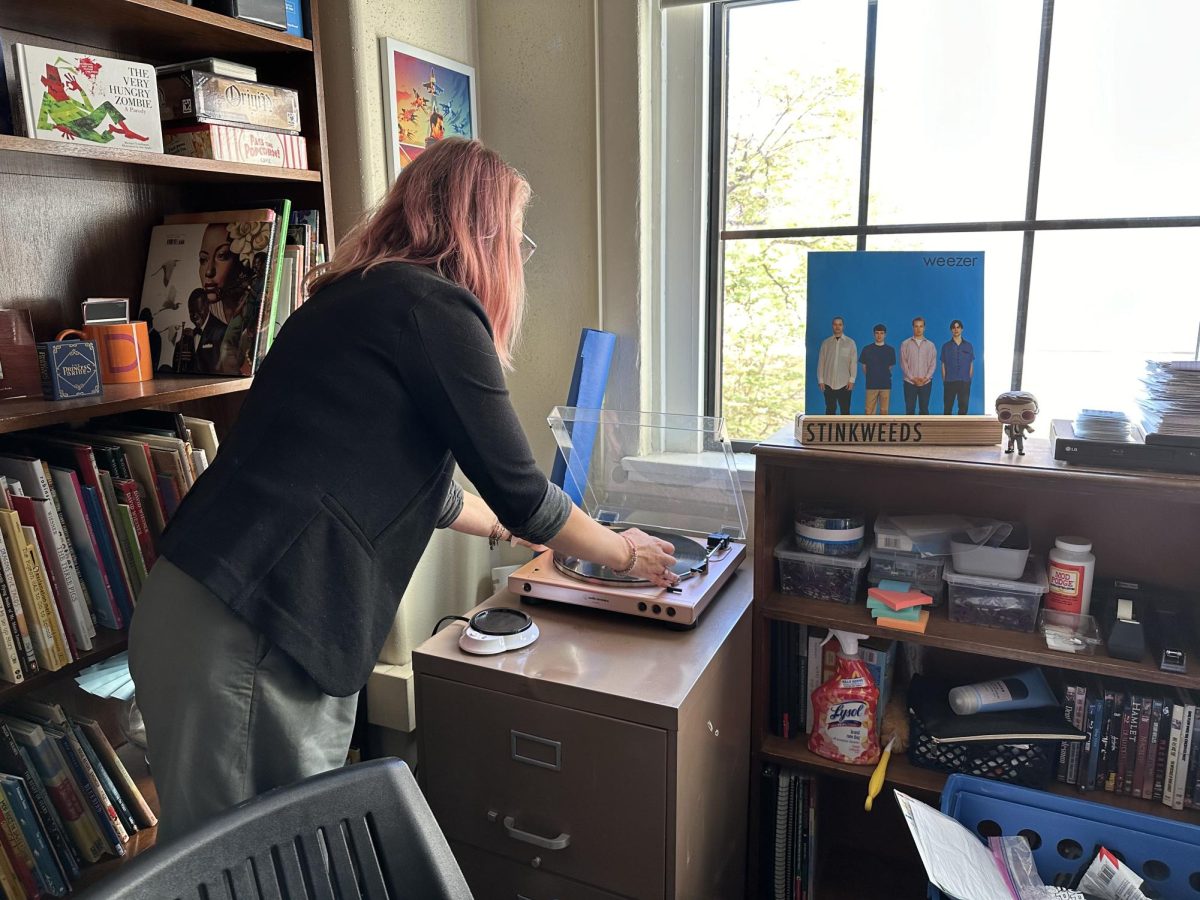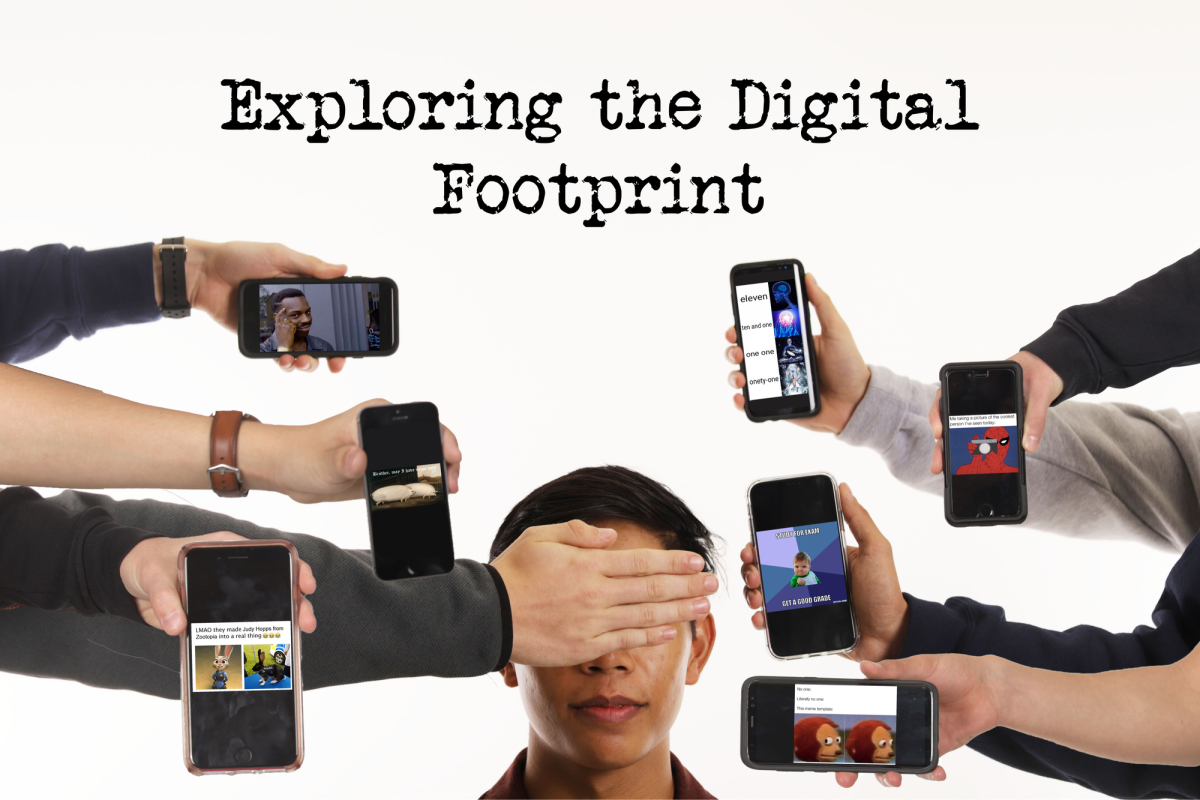Photo Illustration by Victor Beck ’20 and Mark Rossbach ’21 | Students face the daily choice of how they interact with the media and the ways in which they use it. Much of what they do creates a digital footprint that can be traced.
By Ryan Loo ’21 and Carl Justice ’21
THE ROUNDUP
Brophy’s administration is planning an all-school assembly in January in addition to more programming in the spring. Dean of Students Mr. Austin Pidgeon ’08 is in the process of assembling a council of students to work alongside the administration to aid in crafting a policy that encompasses the full range of memes and their influence.
Beginning two years ago, the administration proactively began to address issues stemming from memes, making big steps in the right direction by adding small changes to the Student-Parent Handbook.
Under the harassment section, Brophy added a subsection titled ‘Visual Harassment’, which entails “derogatory, demeaning or inflammatory posters, cartoons, written words, drawings, gestures, memes, microaggressions of any kind.”
“[Visual Harassment] was put in over the last two years,” Mr. Pidgeon said. “We go through a process each summer of revising the student-parent handbook to update it, then revise policies that exist that should be refreshed to respond to the signs of the times.”
As the popularity and prevalence of memes has exponentially grown in relevance on campuses and social platforms throughout the world, this addition to the Student-Parent Handbook was conveniently timed for the administration, allowing for them to have guidelines already set in place for the inevitable issues that arise from ubiquity of memes, which often derive their humor from mocking others.
The administration determined that there are varying levels of interaction with a meme that deem different punishment.
“We always operate by first trying to understand the full context and dig into the particulars of a situation and then respond with sensitivity to the given context,” Mr. Pidgeon said.
After the particulars of a situation are determined, the administration determines which level of interaction has occurred.
According to Mr. Pidgeon, while first level offenders, which are categorized as the creators and original distributors of harmful memes, are considered most problematic, second level offenders also heavily contribute to the problem.
“If I’m screenshotting a [harmful] image and then texting it out in a group thread or posting it on my Snapchat or Instagram stories or something of that nature, that would be a second level offense for us” Mr. Pidgeon said.
Mr. Pidgeon said that the third level offense is affirming the problematic meme by supporting it “in terms of a like, or a laugh” or any other form of appreciation without dissemination.
Brophy Principal Mr. Bob Ryan said that policy adjustments are necessary to adapt to the times.
“We’re constantly assessing and evaluating things from ‘A to Z’ around here to make sure that we’re meeting student [needs] where we are now, through classes that we teach and retreats that we facilitate,” Mr. Ryan said. “Are they meeting the needs of today’s students, or are we still meeting the needs of students in 2002?”
Mr. Ryan, having recently attended a Magis retreat, noted that the recent Magis curriculum addressed a variety of topics that were not discussed on the same retreat ten years prior.
“Some parts are the same because some realities of adolescence are timeless, but there are also needs specific to the era that we live in that we try to meet,” Mr. Ryan said.
Mr. Pidgeon holds the same opinion, regarding the shift in teen culture over time, and explained the impetus for policy changes.
“We typically operate more proactively than reactively. We want to proactively prevent kids from getting themselves into any unsafe situations or doing any harm,” Mr. Pidgeon said. “We also want to react to the reality that our students live in.”
Both Mr. Ryan and Mr. Pidgeon said that talking to students was one of the most important processes in decisions regarding memes.
“Meme culture is pervasive on campus,” Mr. Pidgeon said. “It’s a new reality for us, so I think as an institution, our primary goal … is to listen to kids and to hear the student perspective — what it is, why it’s important to them or not important to them and then what students think we should do about it.”
Mr. Ryan said that student opinions are necessary to get a policy formed.
“We need to make sure that we respond to your guys’ reality,” Mr. Ryan said. “We need to make sure that it’s adults talking to students rather than adults talking to other adults, so we need students to help give us direction there.”
By using a model of student-centered pedagogy, Mr. Pidgeon hopes to steer adults in the right direction.
“I try to deconstruct traditional models of teaching in which teachers are masters and students are pupils,” Mr. Pidgeon said. “You all are the ones who live and observe and engage in this culture, so I think it’s appropriate to give credence to your experience in that. I want to walk with students in their experience rather than to put myself on some false, nonexistent pedestal and assume that I always know better than kids. I just think that’s an unhealthy approach to all things education.”
Mr. Ryan analyzed the varying reactions and levels of interactions with memes, which allegedly reflects how social media is a new and different issue for Brophy to tackle.
“You guys end up affirming images or content or perceptions of people that you would never do in person,” Mr. Ryan said. “We’re all guilty of this. The humanity of the person on the other side is removed, and it becomes a collection of pixels on the other side until you’re at the end of it.”
Mr. Ryan said that another reason meme culture has been problematic is because it has coincided with a rise of objectionable behavior within the culture of the United States.
“I think the real problem that we’re experiencing is a different level of tolerance and acceptance of objectionable, harmful, insulting and uncharitable ways of talking about each other,” Mr. Ryan said. “I think that you are not to blame. The culture that you have been living in for the last four years as young men trying to become members of the community, you have seen people at the highest levels in our country behave that way. Not only have they gotten away with it, but they’ve been applauded and celebrated.”
Mr. Ryan said that Brophy’s mission is to develop its students to be a more positive force for change.
“I think I’d say that everything about [Brophy] tries to combat that [negative culture]. If students came to us fully formed and the embodiment of the Grad at Grad as 14-year-olds, there’s no reason for us to be here,” Mr. Ryan said. “We’d close down.”
Some students noted a disconnect between the administration’s opinion on memes and what other students believe Brophy’s policy upholds.
“I think a lot of people think that the administration things that memes are unequivocally bad and that the administration just hates them, but from what I’ve heard from Mr. Ryan, that’s not the case,” said Calvin Tyler ’20.
Mr. Ryan corroborated Tyler’s statement.
“I don’t think memes themselves are the issue. It’s just like people that blame social media,” Mr. Ryan said. “I think social media is the vehicle and memes, right now, are the instrument of choice.”
Some students think Brophy is inconsistent or unclear in disciplinary action regarding memes.
“I believe that the administration uses arbitrary rules to say what is offensive within meme culture,” said Nolan Lopez ’21. “I specifically would like to see some more specific guidelines as to determine what’s offensive and not.”
Harrison Chung ’21 is not sure what Brophy’s policy on memes is.
“People have said that Brophy is cracking down on memes,” Chung said. “It’s hard to tell what information is real until Brophy comes out with a policy on it.”
Mr. Pidgeon hopes to clarify these issues in the future.





















